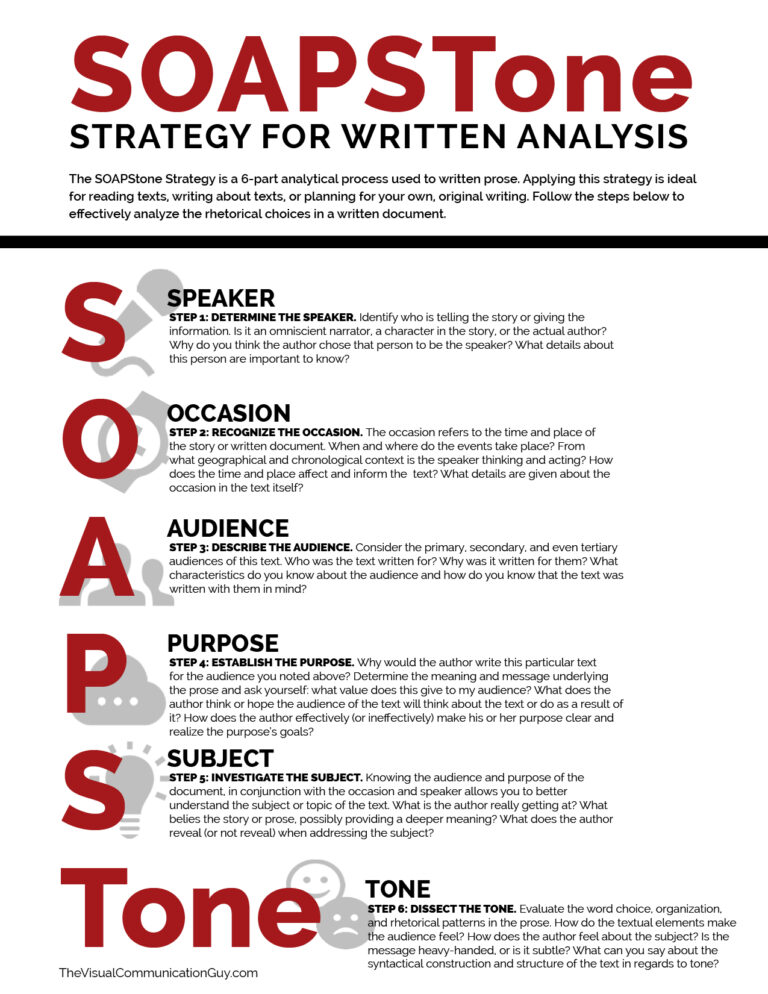SOAPSTone Analysis: Essay Planning
Introduction
For many students, the creation of a piece of writing is a mysterious process. It is a laborious, academic exercise, required by teachers and limited to the classroom. They do not see it as a way of ordering the mind, explaining their thoughts and feelings, or achieving a personal voice.
One of the problems for these students is that they have no conscious plan that will enable them to begin the process and then to organize and develop their ideas. Without a strategy, particularly if they are under time constraints, they simply begin to write and the quality of their compositions is often erratic.
Students need to recognize that any good composition, whether written, spoken, or drawn, is carefully planned. This composition has integral parts that work together in a complex and subtle arrangement to produce meaning. Originally conceived as a method for dissecting the work of professional writers, SOAPSTone provides a concrete strategy to help students identify and use these central components as a basis for their own writing.
SOAPSTone (Speaker, Occasion, Audience, Purpose, Subject, Tone) is an acronym for a series of questions that students must first ask themselves, and then answer, as they begin to plan their compositions.

Source
Morse, O. "SOAPSTone: A Strategy for Reading and Writing." AP Central, https://apcentral.collegeboard.org/ courses/resources/soapstone-strategy-reading-and-writing. Accessed 7 Sept 2019.
S: Who is the Speaker?
The voice that tells the story. Before students begin to write, they must decide whose voice is going to be heard: their own, or a fictional character. Regardless, students should determine how to insert and develop those attributes of the speaker that will influence the perceived meaning of the piece.
(Who are you? What details will you reveal? Why is it important that the audience know who you are?)
O: What is the Occasion?
The time and the place of the piece; the context that prompted the writing. Writing does not occur in a vacuum. All writers are influenced by the larger occasion: an environment of ideas, attitudes, and emotions that swirl around a broad issue. Then there is the immediate occasion: an event or situation that catches the writer’s attention and triggers a response.
(How does your knowledge of the larger occasion and the immediate occasion affect what you are writing about?)
A: Who is the Audience?
The group of readers to whom this piece is directed. As they begin to write, students must determine who the audience is that they intend to address. It may be one person or a specific group. This choice of audience will affect how and why students write a particular text.
(What are the characteristics of this group? How are they related to you? Why are you addressing them?)
P: What is the Purpose?
The reason behind the text. Students need to consider the purpose of the text in order to develop the thesis or the argument and its logic. They should ask themselves, “What do I want my audience to think or do as a result of reading my text?”
(Explain to yourself what you hope to accomplish by this expression of opinion. How would you like your audience to respond?)
S: What is the Subject?
Students should be able to state the subject in a few words or phrases. This step helps them to focus on the intended task throughout the writing process.
(Just a few words. What are you talking about?)
T: What is the Tone?
The attitude of the author. The spoken word can convey the speaker’s attitude and thus help impart meaning through tone of voice. With the written word, tone extends meaning beyond the literal, and students must learn to convey this tone in their diction (choice of words), syntax (sentence construction), and imagery (metaphors, similes, and other types of figurative language). The ability to manage tone is one of the best indicators of a sophisticated writer.
(What attitude[s] do you want your audience to feel? How will your attitude[s] enhance the effectiveness of your piece? Choose a few words or phrases that will reflect a particular attitude.)
Using the Strategy
Students should complete a SOAPSTone analysis before they begin responding to an essay writing prompt, whether it is narrative, persuasive, or analytical in nature.
The SOAPSTone strategy may appear to be somewhat formulaic and rigid, but it helps students, especially novice writers, clarify and organize their thoughts prior to writing. It provides a specific structure for the text; by the time students have finished answering the SOAPSTone questions, they will have an outline of what they think, where they are going with their ideas, and why they are writing.
This strategy is not a substitute for the hard work and practice necessary for students to increase their skill in the use of language or in the development of individual writing styles. But it is an important first step.